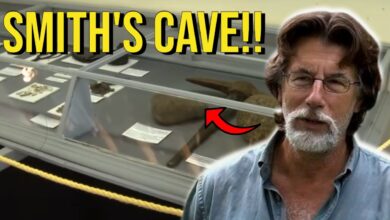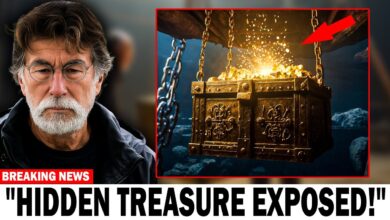HUGE Discovery in 900 Year Old Well | The Curse of Oak Island (Season 10)
HUGE Discovery in 900 Year Old Well | The Curse of Oak Island (Season 10)

The well looks rather full. Looks clean, though.
Jack Begley, along with archaeologists Laird Niven and Helen Shelton, arrive on Lot 26 to continue searching the 900-year-old stone well for clues that might explain who built it, as well as evidence that it contains something of value.
“What’s our plan today?”
“We’re going to pump it out, and then I was thinking if you wouldn’t mind scooping out the debris, but we’re going to save it on a tarp as best we can, and hopefully find an artifact.”
“Yep, if we find something that’s dateable down there, even better.”
“All right, well, let’s get started.”
“All right, we’re gonna need the, uh, Jenny turned on.”
“Jenny turned on. I’ll do that.”
The team is especially interested in the well, not only because it is one of the oldest man-made features ever discovered on Oak Island, but also because a recent water test conducted inside it by Dr. Spooner revealed high trace evidence of silver.
“There you go.”
“The well on Lot 26 is interesting because we’ve got an elevated level of silver in the water. How do you explain that?”
“Which, the pump works really quickly. It’s been speculated before there are constructs across the width and breadth of the island that could possibly be used as a quote-unquote bank.”
“And you have to remember that Oak Island is somewhat remote, so where would you put something that you fancied or thought was precious to you?”
“Well, you might hide it in an old well.”
“Jack will do the, when we get down there, the scooping.”
“I mean, that can already start to scoop it, right?”
“Yep.”
While Laird works to keep the pump clear of debris, Jack will scoop the muck and detritus out of the well onto a tarp, which Helen will carefully sift through for clues once it all dries out.
“I feel like I’m getting to a more gravelly, rocky layer.”
“Okay, good.”
“There, now you can see it.”
“It’s actually beautifully rounded here. It’s a nice round well to a certain point, and then all the angular rocks start coming in.”
“Yeah, like these up here seem quite out of place.”
“Yeah, those big ones.”
Lot 26 has become very interesting as well. It is as old as the 11th century.
“What do I do with that?”
“But it does fit a couple of other outliers on the island. We have the paved area in the swamp, we have a so-called ship’s railing.”
“So it’s astounding. I can’t explain it.”
“Oh yeah, there’s still a lot of muck down there. There’s a lot of debris. It’s going to kind of be a process over days to be able to clean up the water enough to pump it effectively, but I might have the answers we need at the bottom.”
“I must say, I’ve never excavated like this before.”
“Well, there’s a first time for everything, right?”
“Yeah.”
Later that afternoon…
“Which do you want to do first?”
“That one, sure.”
Outside the Oak Island Interpretive Center, Helen Sheldon and metallurgist Emma Culligan begin carefully sifting the dried spoils that were collected earlier from the stone well on Lot 26.
“That’s a misty.”
“It’s just a lot of organics.”
[Music]
“Emma and Helen have taken the initiative to create a sifting station, if you will.”
“Then for sure there’s nothing here, just look it over the side. Hopefully there’ll be an artifact or two within that material.”
“I just think there’s something uniquely strange about this well, and I hope—no pun intended—that we get to the bottom of it.”
“I’m gonna give it a soaking.”
“Mm-hmm.”
“Oh, there’s something.”
“Give me the bag.”
“It’s definitely, definitely iron.”
“Looks and rust.”
“Shape is really weird.”
“Maybe a file?”
“Yeah, because it looks broken or torn off here.”
“It does, which is weird unless that’s the tip that’s come off, but would you say that’s a nail? Because I wouldn’t say it’s a nail.”
“No, it doesn’t look right.”
“So the tip right here is rounded and it seems intentional. Well, down here, it seems like it could have been longer.”
“Yeah.”
“Yeah, really sulfuric, actually. Yeah, which makes it old.”
“We’re finding more and more at sulfur content and iron this year.”
“It just means it was made within a furnace of lower temperatures, so that is an indicator that it is older iron. So just from that alone, I’m thinking around the 1700s.”
“So maybe we should give Rick a text and see if he wants to come and see?”
“All right.”
“Send, okay.”
“Well, what have you found?”
“So, we found a piece of metal that we think is not a nail.”
“Where’s that?”
“So this is the piece.”
“It’s nail-like, but we’re pretty sure it’s not a nail.”
“What do you mean it was a nail, but not a nail?”
“So it kind of does look like a nail, but… so the tip right here is rounded and it seems intentional. Well, down here, it bends, and the fact that the tip is torn off here, so it’s actually probably longer around here, right?”
“So, cut nail maybe? I don’t know. I can’t be for certain because I haven’t CT scanned it.”
“Right.”
“So one question I heard that in the old days, when they used nails on shipbuilding, they’d hammer them in, but they’d been clenched them—clench them. Could that be a clinch possibly?”
“Yeah, and to me it looks hand-rod.”
“Yeah, so it is a pretty old metal.”
“Age-wise, it could be from the 1700s.”
“Great.”
“A possible hand-rod nail, potentially related to a large sailing vessel, because machines came into use for nail production beginning around 1800. Could metallurgist Emma Culligan be correct that this artifact may predate the discovery of The Money Pit in 1795?”
“If so, just when was it made, and how might it be related to the 900-year-old well that it was found in on Lot 26?”
“The material itself, it’s like pretty heavy, right? You can see from the patina that its rust is the main ingredient, but it’s also in pretty good condition, like the rust itself. There’s not much buildup of it.”
“It doesn’t really surprise me much. Metal should last almost forever in that muck.”
“Yeah, you’ll have to finish going through this. I would assume then put it in the CT scanner and see what it says.”
“Yeah, that’s interesting. Yeah, at least there’s stuff today that’s human-made.”
“Yep. We’ll wait and see what the machine says about that iron.”
“This certainly would be a candidate for further investigation to allow that little item to possibly tell us a story.”
“Okay, well, we’ll let you continue with your work. We have another bucket to go.”
“Good, yep.”
“Well, thank you very much.”
“Thank you.”
“All right, see ya.”
“Yep.”
Approximately 50 miles northeast of Oak Island, in Halifax, Nova Scotia…
“Hi!”
“Hi.”
Dr. Brousseau, Peter Frenetti, Oak Island historian Charles Barkhouse, and metallurgist Emma Culligan arrive at St. Mary’s University.
“So, what are you bringing in today?”
“We have a couple of interesting finds.”
They have arranged to have chemist Dr. Christa Brousseau analyze the mysterious iron artifact found one day ago in the stone well on Lot 26.
“So this was on the top layer of the well, so yeah, obviously iron. It could be some form of file, right?”
“Yeah.”
“You know, one thing you’ll notice is it has a sort of rectangular shape, which is quite characteristic of hand-rod nails.”
“So, I’ll take a small sample of this one.”
“Sounds great.”
“All right.”
Lot 26 is one of the most unique lots on this island, so I’m always hopeful that we get that pre-1840s, no manganese results.
“That sample is set then?”
“Yep.”
“All right, we’re ready to have a look at these samples and see what Lot 26 has to tell us today.”
“All right, let’s go downstairs.”
“You can find all the artifacts you want, but at the end of the day, they have to tell a story. We need to try to figure out a timeline. How old is it?”
“There’s potential here to uncover a mystery.”
“Hey Sean, how are you doing today?”
“Hi, I’ve got some visitors here.”
Assisting Dr. Brousseau is her colleague Dr. Sean Yang.
“Sean, we’ve got two sample silicas today.”
In order to analyze the artifact samples, the first one we’ll look at is the first sights. Doctors Brousseau and Yang will use a scanning electron microscope, or SEM.
By magnifying objects up to 200,000 times their actual size, the SEM can identify not only the chemical composition of the items but also help determine their age and geographic regions of origin.
“So there we have a nice piece of iron. No manganese, so again we use that as a marker that it’s, uh, pre-1840, most likely.”
“It does look like an older iron.”
“That pre-1840 is good for us because we have Carmen, who kind of gave us the general idea that it’s 1650, and so I would say that’s consistent with these artifacts we’re finding. I think it just speaks to itself that there’s activity that happened on this lot prior to any inhabitants being on Oak Island. It’s nowhere near The Money Pit.”
“The question is, what were they doing there? And, you know, were they depositing something? Was that an access point or was it an exit point?”
“Yeah, I think Lot 26 still has a lot of secrets for you guys.”
“Yeah, we have some really good information to share with the guys back on the island, so thank you, and hopefully, we’ll be back in the future.”
“There you go, you’re welcome. Take care. Thanks a lot for coming.”
“I know, bye-bye.”
[Music]








